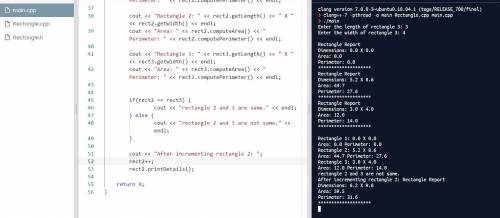
Computers and Technology, 06.05.2020 02:05 shauntleaning
This chapter uses the class rectangleType to illustate how to overload the operators +, *, ==, !=, >>, and <<. In this exercise, first redefine the class rectangleType by declaring the instance variables as protected and then overload additional operators as defined in parts 1 to 3.
1. Overload the pre- and post-increment and decrement operators to increment and decrement, respectively, the length and width of a rectangle by one unit. (Note that after decrementing the length and width, they must be postive.)
2. Overload the binary operator - to subtract the dimensions of one rectangle from the corresponding dimensions of another rectangle. If the resulting dimensions are not positive, output an appropriate message and do not perform the operation.
3. The operators == and != are overloaded by considering the lengths and widths of rectangles. Redefine the functions to overload the relational operator by considering the areas of rectangles as follows: Two rectangles are the same, if they have the same area; otherwise, the rectangles are not the same. Similary, rectangle yard1 is greater than rectangle yard2 if the area of yard1 is greater than the area of yard2. Overload the remaining relational operators using similar definitions.
4. Write the definitions of the functions to overload the operators defined in parts a to c.
5. Write a test program that tests various operations on the class rectangleType.
class rectangleType {

Answers: 3
Another question on Computers and Technology

Computers and Technology, 21.06.2019 15:40
Most networking media send data using in which data is represented by only two discrete states: 0s and 1s. a. digital signals b. contiguous signals c. ramp signals d. exponential signals
Answers: 1

Computers and Technology, 23.06.2019 01:20
Me with this program in c++ ! computers represent color by combining sub-colors red, green, and blue (rgb). each sub-color's value can range from 0 to 255. thus (255, 0, 0) is bright red. (130, 0, 130) is a medium purple. (0, 0, 0) is black, (255, 255, 255) is white, and (40, 40, 40) is a dark gray. (130, 50, 130) is a faded purple, due to the (50, 50, 50) gray part. (in other word, equal amounts of red, green, blue yield gray).given values for red, green, and blue, remove the gray part. ex: if the input is 130 50 130, the output is: 80 0 80. thus, find the smallest value, and then subtract it from all three values, thus removing the gray.
Answers: 3

Computers and Technology, 23.06.2019 06:30
Who can provide you with a new password when you have forgotten your old one? your provide you with a new password in case you forget your old one.
Answers: 3

Computers and Technology, 23.06.2019 09:10
Effective character encoding requires standardized code. compatible browsers. common languages. identical operating systems.
Answers: 1
You know the right answer?
This chapter uses the class rectangleType to illustate how to overload the operators +, *, ==, !=, &...
Questions

Mathematics, 12.05.2021 19:40



Mathematics, 12.05.2021 19:40


Mathematics, 12.05.2021 19:40


English, 12.05.2021 19:40


English, 12.05.2021 19:40


Chemistry, 12.05.2021 19:40

Mathematics, 12.05.2021 19:40




Mathematics, 12.05.2021 19:40


Physics, 12.05.2021 19:40





